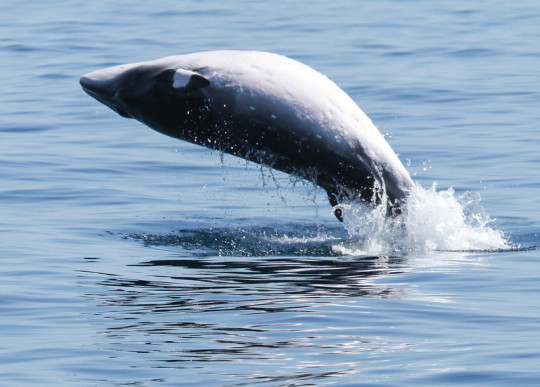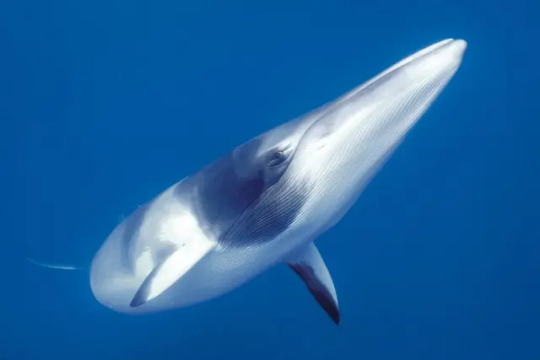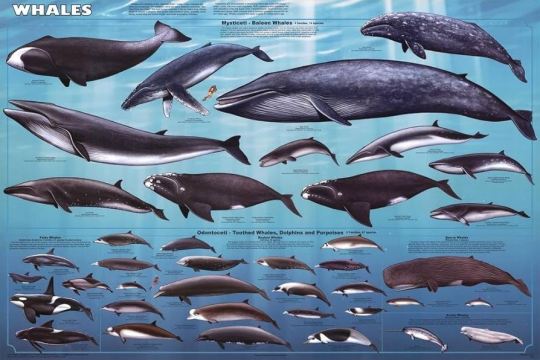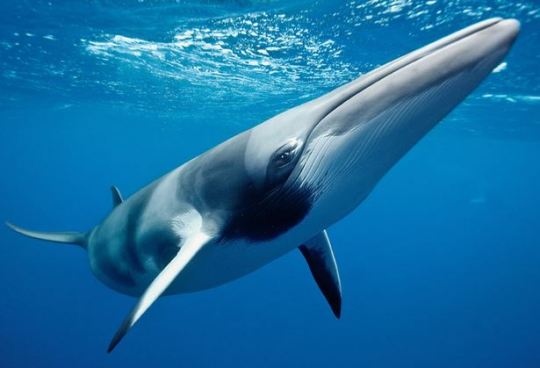#Balaenoptera acutorostrata
Explore tagged Tumblr posts
Note

Trick or Treat!
I couldnt find a costume that fit. Please do not eat me.
(I hope you like the drawing)
Aaaaa this is adorable!! I so loved your drawing, and still do. Makes me smile every time :D Thank you for your participation. For you of course also a treat (and it won't be yourself, lol). I thought I'd try my hand at some cetacean photo studies for these trick or treat asks! Might move things a bit along and I want to practice more at environments. Not sure how long this trend will last lol but for now here's a fellow minke!

Reference is this beautiful photo from inaturalist, shared under de CC-BY-NC license. I loved the moody atmosphere and the reflection on the surface. Did this one in about 30-40 minutes so it's pretty rough but I do like the result. I hope you like it too!
#drawings#Common minke whale#Minke whale#Balaenoptera acutorostrata#Balaenoptera#whale#baleen whale#mysticete#digital art
27 notes
·
View notes
Text

A common minke whale (Balaenoptera acutorostrata) breaches the water in Dana Point, California, USA
by Muriel N.
#common minke whale#minke whale#whales#cetaceans#balaenoptera acutorostrata#balaenoptera#balaenopteridae#cetacea#artiodactyla#mammalia#chordata#wildlife: california#wildlife: usa#wildlife: north america
76 notes
·
View notes
Text

Dwarf minke whale "Balaenoptera" acutorostrata ssp.
Observed by wayneosborn, CC BY-NC
#Balaenoptera acutorostrata ssp.#dwarf minke whale#Cetacea#Balaenopteridae#cetacean#whale#Oceania#Australia#Queensland#Pacific Ocean#Coral Sea
60 notes
·
View notes
Text
🐋Daily Cetacean Fact:🐋
Minke Whale: The common minke whale is the smallest baleen whale in North American waters. The scientific names for minke whales translate to: "winged whale," (Balaenoptera) "sharp snout" (acutorostrata). They received their common name from a Norwegian novice whaling spotter named Meincke, who supposedly mistook a minke whale for a blue whale.


#minke whale#whale#whale post#whale fact#daily whale#daily whale fact#facts about whales#cetacean#cetacean post#cetacean fact#daily cetacean#daily cetacean fact#facts about cetaceans#respect the locals#shark blog#marine mammals#marine life#marine animals#marine biology#marine#marine life blog#marine mammal post#advocacy for marine life#ocean animal#ocean life#ocean#ocean life blog
107 notes
·
View notes
Text
Arctic Ocean Wednesday- Minke Whale 🐋

We’re halfway through the week which means it’s Arctic Ocean Wednesday. The creature of the day is the minke whale. If you want you can request sea creatures for me to make one of these posts about 💙
Scientific name: Balaenoptera acutorostrata
Status: Least concern
Class: Mammals
Population: 500,000+
Lifespan: 30-50 years
Have they been on Octonauts?: No
Minke whales are the second smallest type of baleen whale. Males reach an average length of 8.35m, and females have an average length of 8.9m. Their digestive system contains a high density of anaerobic bacteria, suggesting they extract nutrients from their food using microbial digestion. Minke whales are often preyed on by orcas.



#arctic ocean wednesday#minke whale#whales#marine biology#marine animals#marine life#sea creatures#arctic ocean
13 notes
·
View notes
Text

Minke Whale (Balaenoptera acutorostrata)
12 notes
·
View notes
Text

The #commonminkewhale or northern minke whale (Balaenoptera acutorostrata) is a species of minke whale within the suborder of baleen
2 notes
·
View notes
Text
Kaskelotteja (Physeter macrocephalus) ja lahtivalas (Balaenoptera acutorostrata) Norjanmeressä, ja sit pullokuonodelfiinejä (Tursiops truncatus) Särkänniemen delfinaariossa
whale reference chart :)

pls reblog for sample size etc
follow for more occasional useless polls :)
3K notes
·
View notes
Text
Whales, the majestic giants of the ocean, encompass various species, each unique in its characteristics and distribution. Here's an overview of some prominent whale species, their vocalizations, and global habitats:
1. Blue Whale (Balaenoptera musculus):
- Known as the largest animal on Earth, blue whales inhabit oceans worldwide, preferring deep, open waters. Their vocalizations include low-frequency moans, pulses, and groans, which can travel vast distances underwater, aiding in communication and navigation.
2. Humpback Whale (Megaptera novaeangliae):
- Recognized for their acrobatic breaches and haunting songs, humpback whales frequent both polar and tropical waters during migration seasons. Their songs, characterized by complex sequences of moans, cries, and chirps, are believed to play a role in mating rituals and social bonding.
3. Sperm Whale (Physeter macrocephalus):
- Sperm whales, renowned for their deep-sea dives, are found in all major oceans, with a preference for deeper waters. Their clicks, used for echolocation and communication, are among the loudest sounds produced by any animal, enabling them to navigate and locate prey in the dark depths.
4. Orca or Killer Whale (Orcinus orca):
- As apex predators, orcas inhabit diverse marine environments, from polar regions to tropical seas. Their vocal repertoire includes clicks, whistles, and calls, utilized for communication within pods during hunting and social activities.
5. Beluga Whale (Delphinapterus leucas):
- Belugas, often referred to as "sea canaries" due to their high-pitched vocalizations, reside primarily in Arctic and sub-Arctic waters. Their sounds consist of whistles, chirps, and clicks, facilitating social interactions and navigation in icy habitats.
6. Gray Whale (Eschrichtius robustus):
- Gray whales undertake one of the longest migrations of any mammal, traveling between feeding grounds in the Arctic and breeding grounds in the warmer waters of the Pacific. Their vocalizations are less studied but include low-frequency rumbles and grunts.
7. Fin Whale (Balaenoptera physalus):
- Fin whales are distributed across all major oceans, favoring deep offshore waters. Their vocalizations consist of rhythmic, low-frequency pulses and moans, often referred to as "songs," which likely serve communicative purposes during migration and social interactions.
8. Minke Whale (Balaenoptera acutorostrata):**
- Minke whales are found in both polar and temperate waters worldwide, often near the coastlines. Their vocalizations are relatively simple compared to other species, consisting mainly of pulsed calls and short bursts, possibly used for navigation and communication.
These descriptions offer a glimpse into the rich diversity of whale species and their vocal behaviors across different marine habitats. From the haunting melodies of humpbacks to the powerful clicks of sperm whales, each species contributes to the intricate tapestry of oceanic life, highlighting the importance of conservation efforts to protect these magnificent creatures and their habitats.
https://youtu.be/gbWQSONI3Fg?si=Y_zhdECcu_HbMQ1y
#Whales#the sounds of Whales#oceans#youtube#type of Whales#how many kinds of Whales are there#where in the world you can find whales#give me a video about whales#gardening
1 note
·
View note
Photo

Just passing by
Dwarf Minke Whale - Balaenoptera acutorostrata
Ribbon Reef, Great Barrier Reef, Queensland
Photographer: Pam Osborn
#pam osborn#photographer#australian geographic#dwarf minke whale#whale#balaenoptera acutorostrata#ribbon reef#reef#great barrier reef#queensland#nature
13 notes
·
View notes
Text

Dwarf minke whale | Balaenoptera acutorostrata
X
887 notes
·
View notes
Photo

Is it still murder if no one cares
Is it?
#paintings#this was really enjoyable from start to finish#and i'm super pleased with the result#killer whale#orcinus orca#orcinus#orca#minke whale#common minke whale#northern minke whale#Balaenoptera acutorostrata#balaenoptera#acutorostrata#minke#whale#digital art
349 notes
·
View notes
Text

Grzimek's Animal Life Encyclopedia, vol. 11, Mammals II. 1972.
1.) Grey whale (Eschrichtius robustus)
2.) Sei whale (Balaenoptera borealis)
3.) Common minke whale (Balaenoptera acutorostrata)
4.) Fin whale (Balaenoptera physalus)
152 notes
·
View notes
Text

North Atlantic minke whale "Balaenoptera" acutorostrata acutorostrata
Observed by pcrosson, CC BY-NC
#Balaenoptera acutorostrata acutorostrata#North Atlantic minke whale#Cetacea#Balaenopteridae#cetacean#whale#North America#United States#Massachusetts#Atlantic Ocean#Gulf of Maine
50 notes
·
View notes
Note
Got any whale facts?
1. The largest living thing on Earth is a minke whale, in the Arctic.
2. The smallest living thing is the sperm whale, which is also known as the "great whale" or "fin whale."
3. Sperm whales live in the tropical seas of the Atlantic Ocean and Indian Oceans.
4. The largest sperm whale, Orcinus orca, has been filmed from a distance traveling at up to 62 mph.
5. As of 2015, sperm whales have surpassed blue whales in length.
6. The largest sperm whale ever to be captured was a minke whale, caught in the 1930s off the coast of Japan.
7. The smallest sperm whale ever to be captured was also a minke whale, caught off the coast of Japan in the 1930s.
8. Giant sperm whales are rarely seen.
9. Sperm whales can grow up to 25 feet long.
10. The longest lived sperm whale is Taiji's sperm whale, which had a lifespan of about 60 years.
11. Sperm whales can swim great depths.
12. In 1997, a minke whale was caught off the coast of Japan. The whale was frozen and then thawed and then frozen, repeated.
13. There is a sperm whale population that hunts other sperm whales in the high seas.
14. Sperm whales are the only whales capable of a "sperm gun" attack. The sperm gun is a explosive that the sperm whale shoots at its prey. Sperm whales sometimes kill their prey by ramming it with their huge tails.
15. Sperm whales feed by stretching their tongues and vibrating them together in a "surfer's" motion.
16. The whale shark is the largest bony fish and eats plankton from the surface of the ocean.
17. Most sperm whales, or so-called "pod whales" are in their last decade of life.
18. The sperm whale sometimes lies on its back and vibrates its tail, creating a strobe light effect.
19. A sperm whale can produce a jet of water as tall as 21 feet (6 meters) in the form of a whale-riding wave. The "whale surf" can last for several hours.
20. The sperm whale is the only baleen whale that will eat bluefish, octopus, cuttlefish and shrimp.
21. The sperm whale can hold its breath for up to 20 minutes and is resistant to freezing and to weather.
22. The sperm whale is the only mammal that can turn its entire body upside down.
23. The spermaceti lizard is the largest lizard and eats mollusks, snails, and small fish.
24. The giant sperm whale is sometimes mistaken for a minke whale.
25. The sperm whale's tongue is five miles (8 kilometers) long.
26. New Zealand is the only country where sperm whales are common.
27. The southern hemisphere has more sperm whales than the northern hemisphere.
28. When sperm whales are found dead, they are usually their tails that are most visible.
29. Minke whales are sometimes mistaken for sperm whales because of their large heads.
30. The southern hemisphere has more sperm whales than the northern hemisphere.
31. The southern hemisphere has four times more minke whales than the northern hemisphere.
32. The minke whale is the second largest whale in the ocean after the sperm whale.
33. New Zealand has two minke whales in the same ocean.
34. The bones in a sperm whale's tail can be used for fishing.
35. The nose bone of the sperm whale is used to make shanking irons.
36. The tongue bone of the sperm whale is used to make shanks.
37. The tongue bone of the minke whale is used to make shanks.
38. Minke whales are the smallest known whales.
39. A sperm whale's head has a 25% greater surface area than a minke whale's.
40. Minke whales have a 57% greater surface area than sperm whales.
41. Humpback whales (Balaenoptera acutorostrata) have a 35% greater surface area than sperm whales.
42. Humpbacks have the highest surface area of any whale.
43. The tongue of the humpback whale can stretch up to 35 feet (10 meters).
44. The tongue of the humpback whale is used to smell.
45. The tongue of a humpback whale can change color from white to yellowish-green.
46. The tongue of a humpback whale is equipped with five "fingers" for smelling.
47. A humpback whale has a "nose" on its nose, which is equipped with four feelers used for tasting.
48. The tongue of a sperm whale can be used to produce butter.
49. When a sperm whale tastes something tasty, it may spit its food out of its mouth.
50. A sperm whale can swim for 70 miles (112 km) in a day.
51. The tongue of a sperm whale can be used as a mold to make jewelry.
52. The tongue of a sperm whale can be used to make cigarette lighters.
53. The tongue of a sperm whale can be used as a mold to make jewelry.
54. Other uses of the tongue include a mold to make salad dressings.
55. A minke whale's tongue is used to produce jewelry.
56. The tongue of a minke whale can be used to produce jewelry.
57. Some people use a minke whale's tongue to make jewelry.
58. The tongue of a minke whale can be used to make jewelry.
59. The tongue of a minke whale can be used to produce jewelry.
60. Minke whale whale meat can be used as a medicinal food.
61. Marine mammals that feed on plankton can grow to great sizes.
62. Sea lillies (Iobarium solitarum) are round marine plants which grow in freshwater.
63. Sea lilies are green when young and will turn blue as they get older.
64. Sea lilies reach a length of 40 inches (101 cm) and have 2-8 tentacles.
65. Sea lilies use their tentacles to capture prey such as shrimps, worms and small fish.
66. Sea lilies will grow more than 20-times their body size during the spring.
67. Sea lilies can grow to up to 5 feet (1.5 m) in height.
68. Sea lilies produce a substance from their stomata which are used to expel waste products from their body.
69. Sea lilies have 16-20 tentacles.
70. The sea lily is sometimes called the "sea cucumber."
71. A sea cucumber can grow to be as long as a quarter-mile long.
72. A sea cucumber has strong claws on its foot and a venomous stinger.
73. Sea lilies are poisonous to humans.
74. The stinger of a sea cucumber can pierce human skin and inject a toxin.
75. People with allergic reactions to pollen have died and been eaten by sea cucumbers.
76. The stinger of a sea cucumber can be used to grow the plants needed to kill the sea cucumber.
77. Sea lilies are poisonous to marine mammals.
78. Sea lilies are part of the rhizome of the ocean.
79. Sea lilies appear to be a great indicator of good water quality.
80. Sea lilies improve the environment by sucking up excess nutrients.
81. Sea lilies help to filter particles from water.
82. Sea lilies produce between 1,300 and 2,000 seeds.
83. The seed pods of sea lilies can be used to plant
3 notes
·
View notes
Text
finnish mammals
majava - European beaver (Castor fiber)
orava - red squirrel (Sciurus vulgaris)
liito-orava - Siberian flying squirrel (Pteromys volans)
tammihiiri - garden dormouse (Eliomys quercinus)
koivuhiiri - northern birch mouse (Sicista betulina)
vesimyyrä - European water vole (Arvicola amphibius)
metsämyyrä - bank vole (Myodes glareolus)
harmaakuvemyyrä - grey red-backed vole (Myodes rufocanus)
punamyyrä - northern red-backed vole (Myodes rutilus)
tunturisopuli - Norway lemming (Lemmus lemmus)
peltomyyrä - field vole (Microtus agrestis)
kenttämyyrä - common vole (Microtus arvalis)
lapinmyyrä - tundra vole (Microtus oeconomus)
idänkenttämyyrä - southern vole (Microtus levis)
metsäsopuli - wood lemming (Myopus schisticolor)
peltohiiri - striped field mouse (Apodemus agrarius)
metsähiiri - yellow-necked mouse (Apodemus flavicollis)
vaivaishiiri - Eurasian harvest mouse (Micromys minutus)
rusakko - European hare (Lepus europaeus)
metsäjänis - mountain hare (Lepus timidus)
siili - European hedgehog (Erinaceus europaeus)
kotipäästäinen - lesser white-toothed shrew (Crocidura suaveolens)
vesipäästäinen - Eurasian water shrew (Neomys fodiens)
metsäpäästäinen - common shrew (Sorex araneus)
idänpäästäinen - Laxmann’s shrew (Sorex caecutiens)
mustapäästäinen - taiga shrew (Sorex isodon)
kääpiöpäästäinen - Eurasian least shrew (Sorex minutissimus)
vaivaispäästäinen - Eurasian pygmy shrew (Sorex minutus)
kontiainen - European mole (Talpa europaea)
vesisiippa - Daubenton’s bat (Myotis daubentonii)
viiksisiippa - whiskered bat (Myotis mystacinus)
ripsisiippa - Natterer’s bat (Myotis nattereri)
pohjanlepakko - northern bat (Eptesicus nilssonii)
korvayökkö - brown long-eared bat (Plecotus auritus)
kimolepakko - parti-colored bat (Vespertilio murinus)
doggilepakko - European free-tailed bat (Tadarida teniotis)
mustavalas - North Atlantic right whale (Eubalaena glacialis)
harmaavalas - grey whale (Eschrichtius robustus)
sillivalas - fin whale (Balaenoptera physalus)
lahtivalas - common minke whale (Balaenoptera acutorostrata)
rhyävalas - humpback whale (Megaptera novaeangliae)
pyöriäinen - harbour porpoise (Phocoena phocoena)
maitovalas - beluga whale (Delphinapterus leucas)
kaksihammasvalas - Sowerby’s beaked whale (Mesoplodon bidens)
valkokuonodelfiini - white-beaked dolphin (Lagenorhynchus albirostris)
rissondelfiini - Risso’s dolphin (Grampus griseus)
miekkavalas - orca (Orcinus orca)
ilves - Eurasian lynx (Lynx lynx)
naali - arctic fox (Vulpes lagopus)
kettu - red fox (Vulpes vulpes)
susi - grey wolf (Canis lupus)
karhu - brown bear (Ursus arctos)
ahma - wolverine (Gulo gulo)
saukko - Eurasian otter (Lutra lutra)
kärppä - stoat (Mustela erminea)
vesikko - European mink (Mustela lutreola)
lumikko - least weasel (Mustela nivalis)
hilleri - European polecat (Mustela putorius)
näätä - European pine marten (Martes martes)
soopeli - sable (Martes zibellina)
mäyrä - European badger (Meles meles)
supikoira - raccoon dog (Nyctereutes procyonoides)
mursu - walrus (Odobenus rosmarus)
halli - grey seal (Halichoerus grypus)
grönlanninhylje - harp seal (Pagophilus groenlandicus)
norppa - ringed seal (Pusa hispida)
villisika - wild boar (Sus scrofa)
hirvi - moose (Alces alces)
metsäkauris - roe deer (Capreolus capreolus)
peura - reindeer (Rangifer tarandus)
21 notes
·
View notes